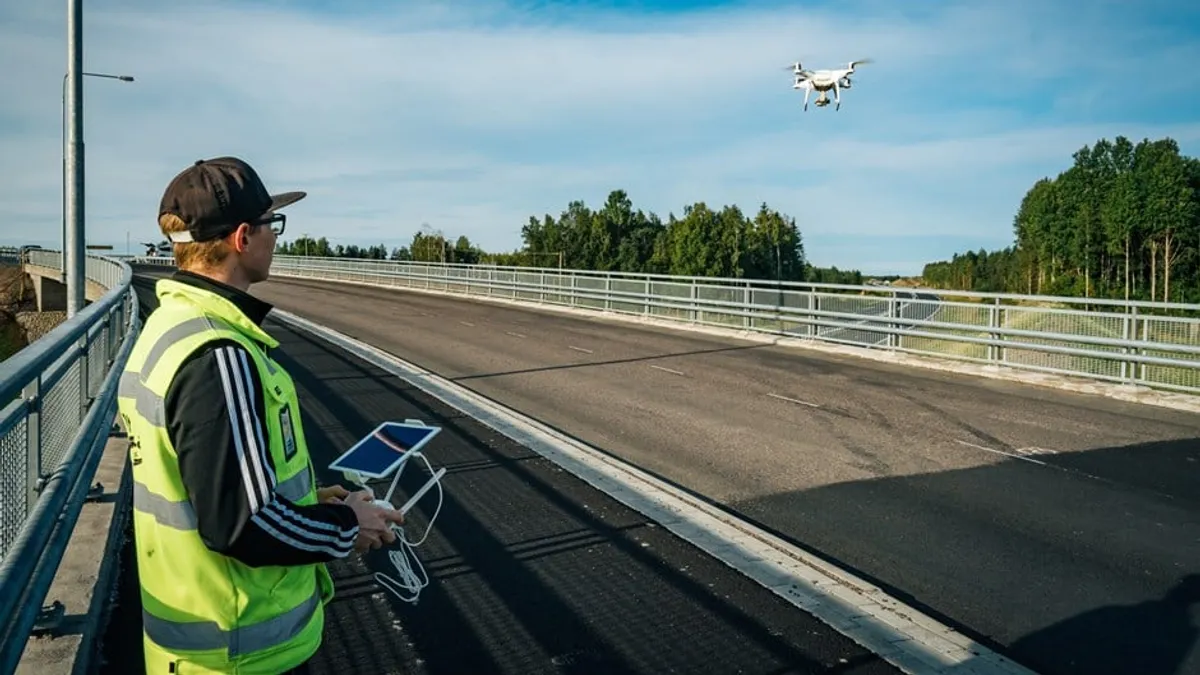As drones become more commonplace on jobsites across the world, Skanska USA has a few tips on how to leverage them.
The contractor’s drone program was started in 2015, and now features more than 70 people across different departments for the U.S. arm of the Swedish contractor. Together, the group comes up with uses for the tech across jobsites around the country.
Now, the program has fostered a sense of community, said Albert Zulps, the director of emerging technologies for Skanska USA Building, leading to photo contests and helpful advice.
“It's grown into a way to see the construction industry. If you fly a drone within Skanska, you have a new lens to look at the industry through all of that technology that drones touch,” Zulps said.
Making the case
Drones started off as a novelty item, Zulps said. They didn’t have the GPS systems they’re equipped with today, which led to a variety of problems.
“I know so many people have stories like that. They flew up there and then a bird flew by, or the wind took it away,” Zulps said.
Matters were further complicated by the Federal Aviation Administration’s approach to integrating drones in 2015, the year Skanska’s organization was launched.
Today, there are federal statutes that govern drone flying, and some states, such as California and Florida, have additional laws. At the municipal level, towns and cities can enact their own drone statutes as well. That means a knowledge of aviation regulations is a must for deploying drones on any jobsite today.
Under the FAA guidelines, new drone pilots must register with the agency through a tracking number, pass a test on drone usage and safety and complete an FAA document to receive a remote pilot certificate. To fly for a business or for commercial use, pilots must adhere to the FAA’s Part 107 guidelines, which cover details such as what constitutes a legal drone, how to comply with regulations and how to keep records.
Drone tips
Ryan Schuck, senior project engineer and a certified drone pilot at Skanska USA Building, described challenges at the Portland International Airport site, where Skanska installed a 2,200-piece, 18-million-pound prefabricated timber roof and provided holistic imagery and 3D models of project progress to the client.
At the airport, the company had to coordinate and work with regulatory authorities to operate the drones in controlled airspace, where regulations are tighter.
Zulps said the team had to keep in touch with the government through the Low Altitude Authorization and Notification Capability, which helps drone pilots get access to controlled airspace at or below 400 feet and notifies pilots where they can and can’t fly.
However, even in non-controlled airspace, there’s a lot to keep in mind, Schuck said.
For example, Schuck flies twice a week on a current project at Oregon Health & Science University, with two emergency helicopter pads on top of the existing hospital complex.
The process to schedule these flights takes advanced prep time — Schuck will send a flight plan to the clients a month in advance. In that plan, he will line up the dates and times that he’s flying, and coordinate with the client to make sure that works.
When flight day comes, Schuck will still need to make sure that he contacts the campus emergency and non-emergency departments and maintain contact with crane operators on the job.
“I think having that open communication with our client has been instrumental and I’m building confidence with our team,” Schuck said.
Have a plan
Schuck also said a large part of success is to know ahead of time what you’re looking to capture with your drone, and to work with your team and trade partners to identify best-use case scenarios.
“I don't think there's a one-case-fits-all for construction. Every construction project has its differences and its challenges,” Schuck said.













